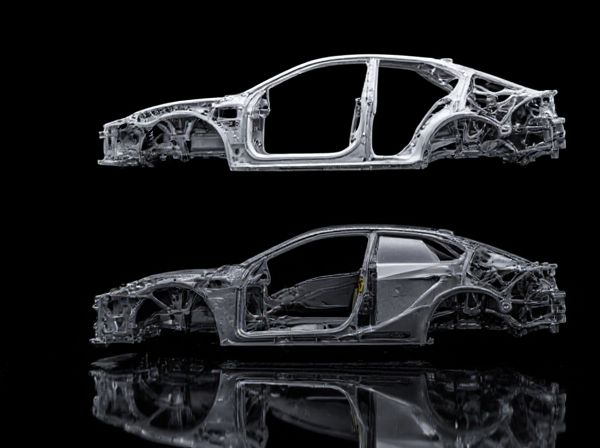
Photo illustration: Spaceframe Chassis vs Perimeter Chassis
Spaceframe chassis offer superior rigidity and weight distribution by using a network of interconnected tubes, enhancing your vehicle's handling and crash resistance. Perimeter chassis focus on a strong outer frame that improves structural integrity and simplifies manufacturing but may add more weight and reduce flexibility in design. Choosing the right chassis depends on your priorities for performance, safety, and customization.
Table of Comparison
| Aspect | Spaceframe Chassis | Perimeter Chassis |
|---|---|---|
| Structure | 3D tubular frame with interconnected beams | Reinforced frame around the vehicle perimeter |
| Weight | Generally lightweight due to minimal material use | Heavier because of solid frame rails |
| Strength & Rigidity | High torsional rigidity and structural strength | Good rigidity but less torsional stiffness than spaceframe |
| Crash Safety | Excellent energy absorption through frame deformation | Strong impact resistance but transfers force along rails |
| Manufacturing Complexity | Complex welding and assembly of multiple tubes | Simpler stamping and welding processes |
| Cost | Higher production cost due to complexity | Lower manufacturing cost, widely used in mass production |
| Application | Sports cars, race cars, lightweight performance vehicles | Passenger cars, SUVs, trucks |
Introduction to Chassis Designs
Spaceframe chassis utilize a network of interconnected tubes or beams, providing exceptional rigidity and lightweight strength ideal for high-performance vehicles. Perimeter chassis, also known as ladder or body-on-frame designs, consist of a robust frame outlining the vehicle's perimeter, offering durability and ease of repair, commonly used in trucks and SUVs. Understanding the distinct structural advantages of spaceframe and perimeter chassis aids manufacturers in optimizing vehicle performance, safety, and weight distribution.
What is a Spaceframe Chassis?
A spaceframe chassis consists of a complex network of welded tubular steel or aluminum members arranged in a geometric pattern, providing high strength-to-weight ratio and superior rigidity. It offers enhanced torsional stiffness and crash resistance, making it ideal for sports cars and racing vehicles where performance and handling are critical. The design distributes forces evenly throughout the frame, improving structural integrity compared to perimeter chassis, which rely on heavier, box-section rails running around the vehicle's perimeter.
What is a Perimeter Chassis?
A perimeter chassis features a structural frame that wraps around the vehicle's outer edges, providing enhanced rigidity and improved crash protection. It distributes impact forces more evenly across the entire frame, resulting in better safety performance and reduced chassis flex during cornering. Compared to a spaceframe chassis, which relies on a network of interconnected tubes, the perimeter chassis typically offers greater ease of manufacturing and repair efficiency.
Key Structural Differences
A spaceframe chassis features a network of interconnected tubes forming a rigid framework that distributes loads evenly, enhancing torsional stiffness and reducing weight. In contrast, a perimeter chassis relies on a strong outer frame surrounding the vehicle's edges, providing structural support primarily along the sides and promoting crash safety. Spaceframe designs excel in performance applications due to their superior rigidity, while perimeter chassis offer simplicity and durability for mass-produced vehicles.
Strength and Rigidity Comparison
Spaceframe chassis offers superior strength and rigidity by distributing stresses evenly across interconnected tubular structures, enhancing torsional stiffness significantly compared to perimeter chassis. Perimeter chassis, constructed with a rectangular frame outlining the vehicle's perimeter, provides moderate rigidity but tends to flex more under high loads, especially in cornering or off-road conditions. Advanced materials like high-strength steel or aluminum alloy used in spaceframe designs further improve performance by optimizing weight-to-strength ratios, making spaceframes preferable for high-performance and racing applications.
Weight Considerations
Spaceframe chassis typically offer superior weight efficiency due to their design, which utilizes a network of lightweight tubes or beams strategically arranged to distribute load evenly. Perimeter chassis, constructed with heavier gauge metal around the vehicle's edges, often result in increased overall weight but provide enhanced rigidity and impact resistance. Choosing between the two depends heavily on the application's priority for lightweight performance versus structural robustness.
Manufacturing Complexity
Spaceframe chassis feature a network of interconnected tubes or beams, requiring precision welding and specialized jigs, which increases manufacturing complexity and demands skilled labor. Perimeter chassis, constructed from stamped metal panels welded or riveted together, benefit from streamlined assembly processes and lower production costs due to standardized components and less intricate fabrication. The structural design of spaceframes often leads to extended production times and higher tooling expenses compared to the more straightforward manufacturing of perimeter chassis.
Cost Implications
Spaceframe chassis typically incur higher manufacturing costs due to their complex tubular steel or aluminum construction, which requires specialized welding and assembly processes. Perimeter chassis are generally more cost-effective because they use simpler stamped steel components and common assembly techniques, reducing production time and material expenses. The choice between these chassis types significantly impacts overall vehicle cost, with spaceframe designs favoring performance and rigidity but at a premium price point compared to perimeter chassis.
Applications in Automotive and Motorsports
Spaceframe chassis, characterized by a network of lightweight tubular steel or aluminum, provides superior rigidity and weight distribution, making it ideal for high-performance racing cars and custom automotive builds that demand exceptional handling and safety. Perimeter chassis, often constructed from stamped steel or aluminum panels forming a boxed structure around the vehicle's perimeter, excel in mass-produced passenger vehicles by offering robustness and ease of manufacturing. In motorsports, spaceframe chassis dominate formula cars and prototypes due to their flexibility in design and weight optimization, while perimeter chassis remain prevalent in rally and touring cars for enhanced durability and crash protection.
Choosing the Right Chassis for Your Needs
Spaceframe chassis offers superior rigidity and weight reduction, making it ideal for high-performance sports cars and racing vehicles. Perimeter chassis provides enhanced durability and easier manufacturing, suitable for daily drivers and heavier vehicles like SUVs. Selecting the right chassis depends on factors such as vehicle purpose, desired handling characteristics, and production costs.
 caratoz.com
caratoz.com